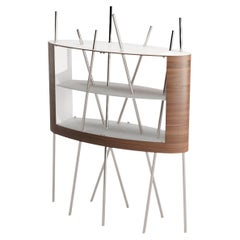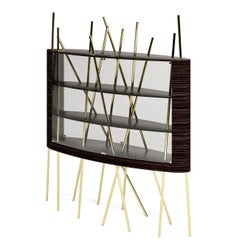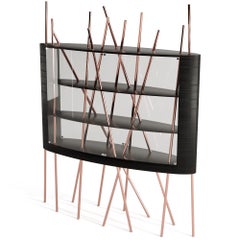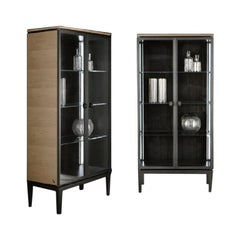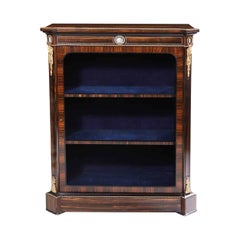Veneer Vitrines
to
23
Height
to
Width
to
Depth
to
89
34
97
27
18
15
14
10
9
5
4
4
3
3
1
1
1
1
2
55
40
27
18
15
1
8
4
1
1
6
123
77
60
48
37
115
49
24
17
10
124
100
104
8
7
7
5
4
Technique: Veneer
Modern Vitrine Display Case Ebony Macassar Wood Black Lacquer Brushed Brass
Located in Vila Nova Famalicão, PT
The Mikado Collection is inspired by the game "Pick a Stick" we used to play in childhood. Tubes of thick brass, which remind us of the Mikado sticks game, ...
Category
21st Century and Contemporary Portuguese Modern Veneer Vitrines
Materials
Metal, Brass
Modern Vitrine Display Case Walnut Wood White Lacquer Brushed Stainless Steel
Located in Vila Nova Famalicão, PT
The Mikado Collection is inspired by the game "Pick a Stick" we used to play in childhood. Tubes of thick stainless steel, which remind us of the Mikado sti...
Category
21st Century and Contemporary Portuguese Modern Veneer Vitrines
Materials
Metal, Steel, Cut Steel, Stainless Steel
Modern Large Vitrine Display Case Ebony Macassar Black Lacquer Brushed Brass
Located in Vila Nova Famalicão, PT
The Mikado Collection is inspired by the game "Pick a Stick" we used to play in childhood. This vitrine, "Mikado Display Case XL," is a beautiful way of fla...
Category
21st Century and Contemporary Portuguese Modern Veneer Vitrines
Materials
Brass, Metal
Modern Large Vitrine Display Case Black Oak Wood Black Lacquer Brushed Copper
Located in Vila Nova Famalicão, PT
The Mikado Collection is inspired by the game "Pick a Stick" we used to play in childhood. This vitrine, "Mikado Display Case XL," is a beautiful way of fla...
Category
21st Century and Contemporary Portuguese Modern Veneer Vitrines
Materials
Metal, Copper
D627 Dragonfly Showcase
By CPRN HOMOOD
Located in Ponsacco, IT
This vitrine of mixed materials has 2 metal frame doors and wooden sides available in 2 different finishes. The black glass with engraved “chevron” ...
Category
2010s European Modern Veneer Vitrines
Materials
Metal
Late 19th Century Calamander Wood Glazed Cabinet
Located in London, by appointment only
A fine late 19th century calamander wood vitrine cabinet, the top, and front veneered in calamander wood and the sides ebonised, the front and corners ...
Category
19th Century English Victorian Antique Veneer Vitrines
Materials
Bronze
20th Century Antique Biedermeier Style Three-Sided Glass Vitrine Bird-Eye Maple
Located in Berlin, DE
Bird’s-eye maple root veneer on solid pinewood, one-drawered curving border-case on plinth-feet. Architecturally bowed front flanked with full columns from solid beech. Carved and ha...
Category
20th Century German Biedermeier Veneer Vitrines
Materials
Wood, Beech
19th Century Biedermeier Style Three-Sided Glazed Glass Vitrine mahogany veneer
Located in Berlin, DE
Three-sided glazed glass vitrine circa 1825 in the sense of Karl Friedrich Schinkel. High-quality Mahogany on solid softwood. Recessed frame box. Architecturally arranged front with ...
Category
19th Century German Biedermeier Antique Veneer Vitrines
Materials
Mahogany

